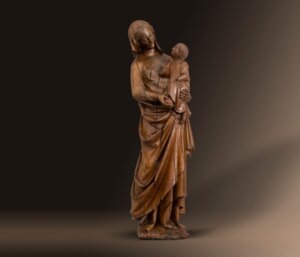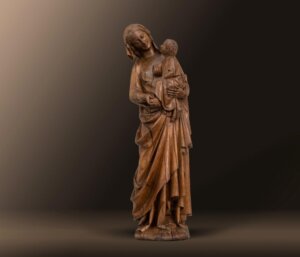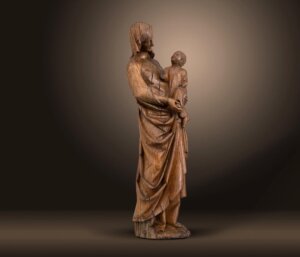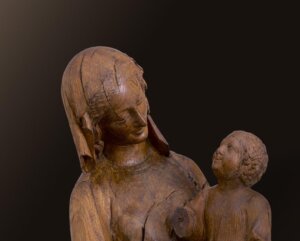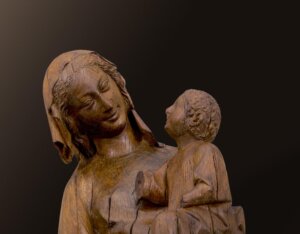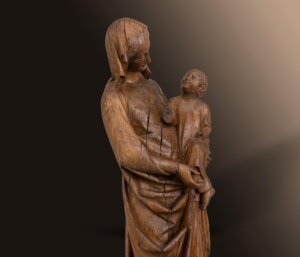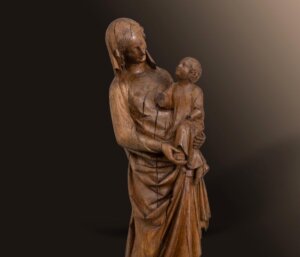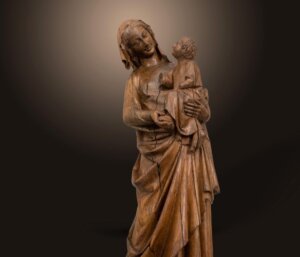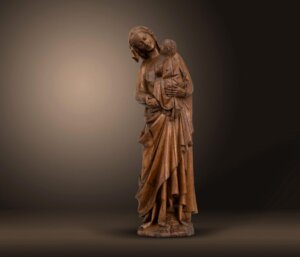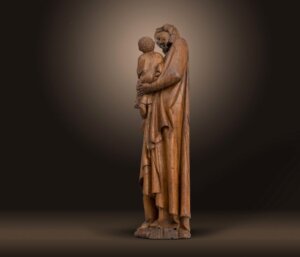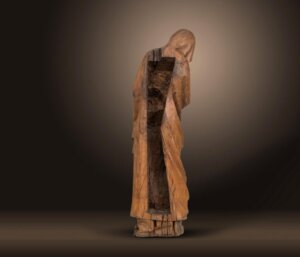This masterfully executed, very well preserved sculpture of the Madonna comes from the
Île-de-France and originated around 1270. It is carved from oak wood and 78 cm high. The figure is hollowed on the back in a straight form, a striking indication of its early dating to the period 1260-80.
Mary stands in a lunge on a massive standing surface, with the right knee, which is slightly bent as a playing leg, visible under the mantle. The diagonal drapery emphasizes the slender elevation of the elongated Mother of God holding her child against her with her left arm. The infant Jesus, typically clothed in 13th-century figures, is perkily facing the mother and gazing up at her, the gazes of mother and child meeting in a silent, intimate exchange. Particularly memorable features of the physiognomy are the elongated, almond-shaped eyes, the sharp ridges of the eyebrows that merge seamlessly into the straight bridge of the nose, and the mouth contorted into a slight smile with deep dimples above a narrow, V-shaped chin. An intimate moment between mother and child is depicted: Mary holds the bare foot of her son with her right hand. At the same time, the baby Jesus presents the bare sole of his right foot. This not only shows the deep relationship between Mary and Jesus, but is also a reference to the human side of Christ. This gesture may well symbolize, in theological interpretation, the incarnation of Christ.
The type of this Madonna figure originated from the French monumental sculpture of the mid-13th century. Comparable are the facial physiognomy and the treatment of the drapery of the sculptures on the west façade of Reims Cathedral or the Virgin on the north portal of Notre Dame de Paris.
In its fine carving, our Madonna is stylistically comparable to the so-called Vierge d’Abbeville from the Louvre, which was also created around 1270 and was also carved from oak. However, their origin is localized in the more northern province of Picardy (RF 1449). Striking stylistic features of both figures are the tight-fitting garment on the torso, the doughy drapery, the bowl pleats falling diagonally in voluminous clusters, and the hems of the dress resting flat on the ground. Likewise, the pleated cloth over Mary’s head and the finely worked main hair are clear characteristics of this period and testify to the highest quality as well as to the great talent of the master sculptor who executed the work. Mary’s dynamically bent posture and the playful crossing of the baby Jesus’ legs are also of the same type. However, in the Il-de-France sculpture, the focus of the delicate, intimate execution is different, namely the lovely attention of mother and child, whose faces are connected by a straight line of sight.
A wood-carved figure with a very related pose and similar drapery, attributed to the area around Paris circa 1270, is now in the Palais des Beaux-Arts de Lille, but in a much poorer state of preservation as well as a typologically different, distant pose of Mary and the infant Jesus.
An early small sculptural example of comparison is made of ivory; the so-called,30 cm high, Dormeuil Madonna, sold at Sotheby’s in 2007 for € 1,488,250. was sold. The tender affection between mother and child is accentuated by the figure’s posture, with the stylized parallel folds of the bowl following the curve of the tusk, giving the figure a graceful elegance. The drapery emphasizes Mary’s game leg as well as the figure’s elevation.
In 2010, a similar Parisian ivory figurine, dating between 1250 and 1280, was sold at Christie’s, with comparable short veil, playing leg exposed by bowl folds, diagonal border, and child’s intimately turned posture.
The finely executed ivory Madonna of Sainte-Chapelle, now in the Louvre (OA 57), dated between 1260 and 1270, shows strong stylistic and typological similarities to our sculpture, both in the folds of the short veil, the three close-fitting bowl folds with strongly bulging fold ridges around Mary’s hip, and the drapery resting in a doughy manner on the base.
Our Madonna bears further striking resemblance to an ivory figure carved in Paris circa 1260-70 in the Metropolitan Museum of Art (17,190,175). Despite the material differences, the execution of the drapery, the hairstyle, the V-shaped face type and the facing posture between Mary and the child are also extremely similar here. While the ivory child has his left hand outstretched towards his mother’s chin, making contact with her, our work presented here shows an even more intimate relationship between mother and child.
Bibliography
P. Barnet, Images in Ivory, Precious Objects of the Gothic Age, cat. exp. Detroit Institute of Arts, Princeton University Press, 1997.
Exposition d’objets d’art du Moyen Age et de la Renaissance organizée par la marquise de Ganay chez Jacques Seligman, Hôtel de Sagan, Paris, 1913.
D. Gaborit-Chopin, “La Vierge à l’Enfant d’ivoire de la Sainte-Chapelle”, La Sainte-Chapelle. L’art au temps de saint Louis, Dijon, Dossiers d’archéologie n. 264, 2001.
D. Gaborit-Chopin et al, “Ivoires Médiévaux Ve-XVe siècle”, Catalogue du musée du Louvre, Paris 2003.
S. Guérin, “Synergy across Media. Gothic sculptors in Wood and Ivory”, G. Davies – E. Townsend (eds.), A reservoir of Ideas. Essays in honor of Paul Williamson, London, Paul Holberton Publishing, 2017, pp. 124-136.
R. Koechlin, Les ivoires gothiques français, Paris, 1924, vol. I & II.
J. Natanson, Gothic ivories of the 13th and 14th centuries, London, Alec Tiranti, 1951, n. 24.
W. Sauerländer, Willibald, La Sculpture gothique en France, 1140-1270, Paris, Flammarion, 1972.
R. Suckale, Studien zu Stilbildung und Stilwandel der Madonnenstatuen der Ile-de-France zwischen 1230-1300, dissertation, Munich, 1971.
P. Williamson, The Wyvern Collection. Medieval and Later Ivory Carvings and SmallSculpture, London, Thames & Hudson, 2019.
P. Williamson – G. Davies, Medieval Ivory Carvings, I-II, 1200-1550 Part I et II, London, V&A Publishing, 2014.
